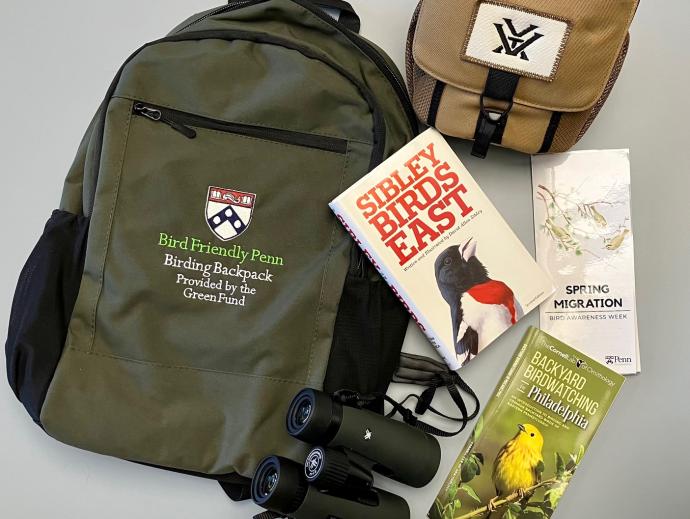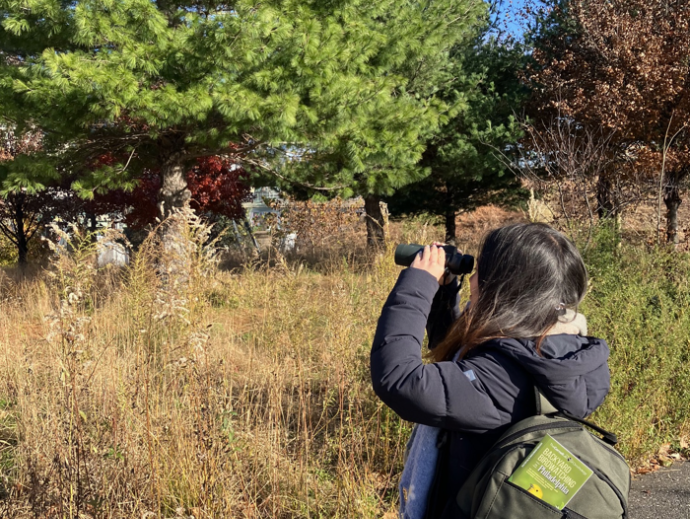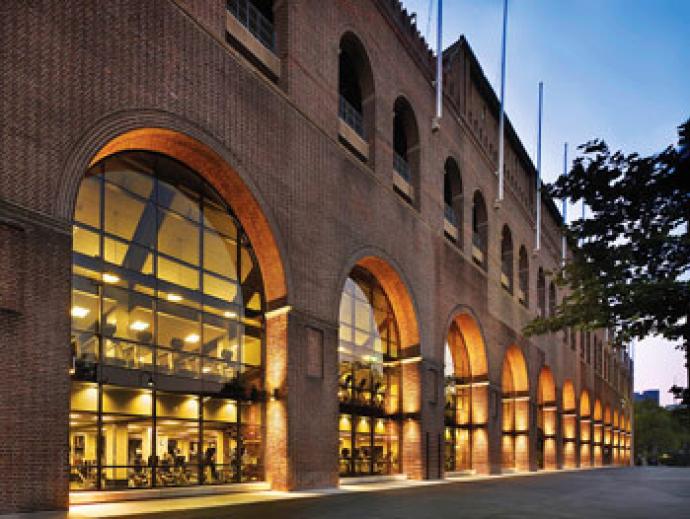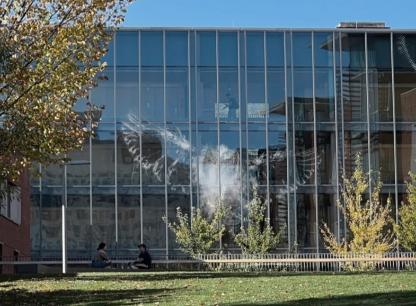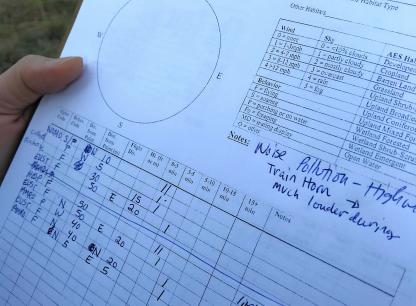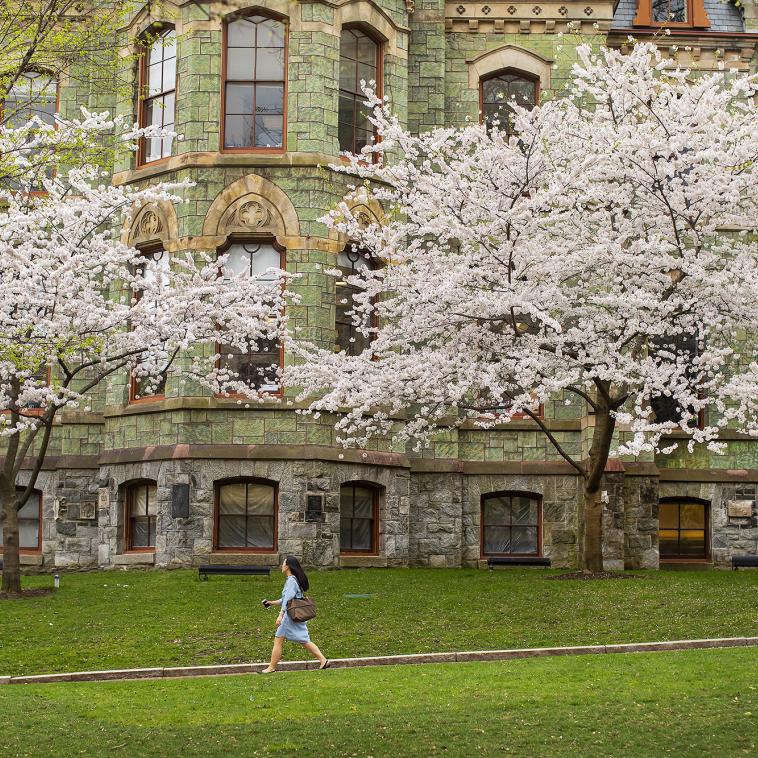Bird-Friendly Penn
Reducing Bird Strikes
Penn's campus is located along the Atlantic Flyway, making it an important stopover spot for birds during migration. The Bird-Friendly Initiative seeks to reduce bird strikes and building collisions through implementation of bird-friendly building design and campus outreach.
Reducing Bird Strikes
Penn's campus is located along the Atlantic Flyway, making it an important stopover spot for birds during migration. The Bird-Friendly Initiative seeks to reduce bird strikes and building collisions through implementation of bird-friendly building design and campus outreach.
Overview
Since 1970, North American bird populations have plummeted by nearly 30% - a particularly alarming figure given that birds are essential for human and environmental health and wellness, providing pest control, pollination, seed propagation, and adding cultural and economic value. In the Fall of 2020 alone, over 1,000 birds were found dead after they flew into buildings and skyscrapers across Philadelphia, in part due to Philadelphia’s central location along the “Atlantic Flyway,” a common migration route for over 500 different species of birds. When these migratory birds encounter the unfamiliar urban landscape, they’re often unable to recognize the see-through and sky-reflecting glass of urban buildings, crashing into them at fatal speeds. These bird deaths are entirely preventable.
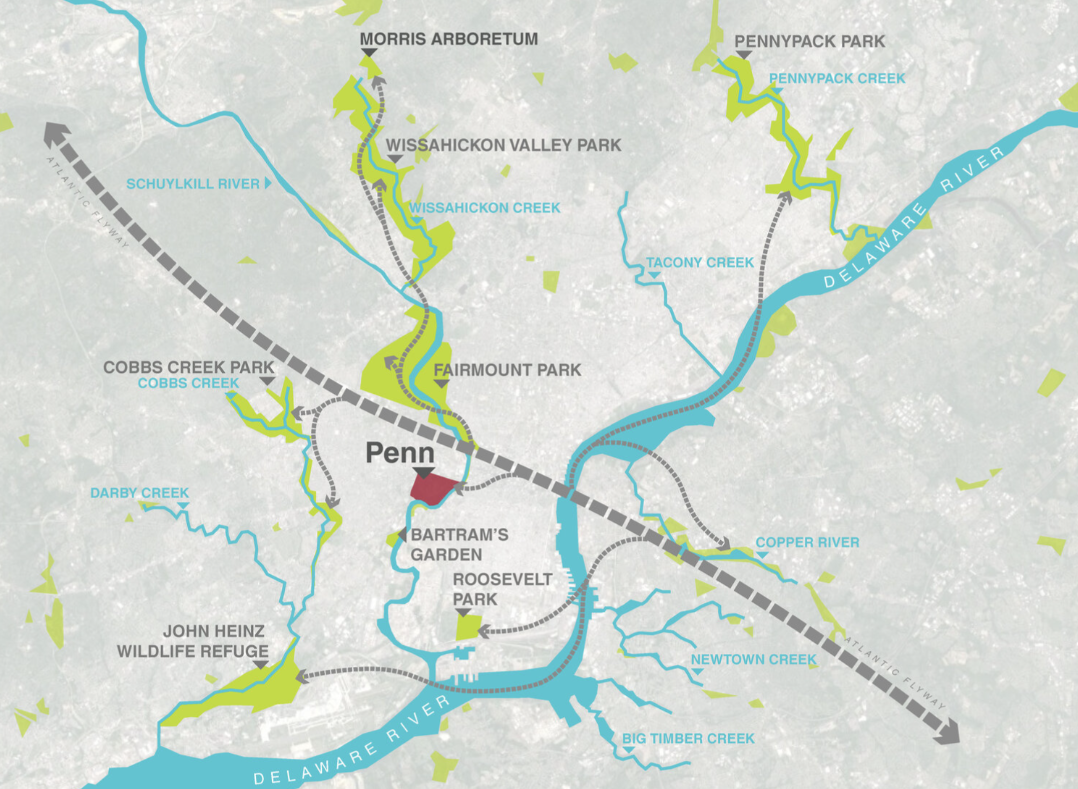
Map of region along the Atlantic Flyway, highlighting campus, key parks, rivers, and creeks. (ELSP)
Today, members of the Penn student body, faculty, and staff are working together to make Penn’s campus more environmentally conscious by reducing the number of bird strikes as part of Bird-Friendly Penn. This initiative is spearheaded by the FRES Landscape Architecture Group in partnership with Audubon Mid-Atlantic, Bird-Safe Philly, and Penn Sustainability. Ongoing research is being conducted to document the frequency and location of campus bird strikes, and novel solutions to integrate bird-friendly technology into building architecture, such as UV reflective coatings, are being tested. Outreach materials such as a logo, lawn signs, and brochures were created through a partnership between Colleagues in the Stuart Weitzman School of Design.
Get Involved
Students, staff and faculty, and all members of the Penn community are encouraged to become involved in bird-friendly efforts.
Citizen Science
The Penn Community is active in documenting the frequency and location of bird strikes as well as bird sightings on our campus. Available on Android, iOS, and web browser, iNaturalist is an easy-to-use citizen science application that empowers users to map and observe biodiversity across the world. Collecting this data allows us to better understand campus hotspots and prioritize mitigation efforts.
Link field url: #resources
Resources
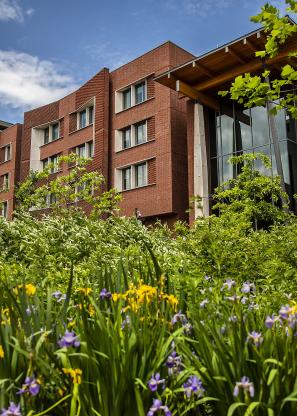
Bird-Friendly Design Guidelines
Guidance for the evaluation of bird-friendly design strategies in new buildings and applicable renovation projects.

Bird Spring Migration Brochure
Learn more about Bird Awareness Week and how you can support birds migrating through Penn's campus.
Buildings
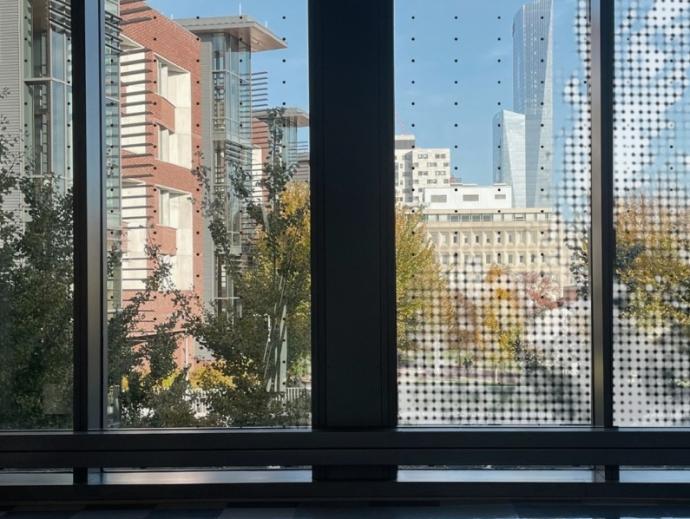
Bird-Friendly Buildings at Penn
Bird-friendly building design guidelines aim to reduce bird collisions with structures by incorporating features that make buildings more visible or less attractive to birds. During building renovations and new construction, a variety of bird-friendly architectural elements are integrated into designs, aiming to minimize bird collisions.
Campus as a Living Lab
Our campus operates as a dynamic living lab, blending academic study with hands-on experimentation across fields like sustainability, technology, and urban planning. This immersive approach equips students to tackle real-world challenges, fostering creativity and problem-solving skills essential for addressing complex issues post-graduation. Below are a few examples where students, staff, and faculty, combined this concept of campus as a living lab and bird-friendly initiatives:
The Motus Wildlife Tracking System, a wildlife tracking technology that emerged in 2014, has the power to fill in the gaps about where, when, how, and why birds migrate, without needing to recapture individual birds. A program of Bird Studies Canada in partnership with collaborating researchers and organizations, Motus consists of an array of antennae installed at a variety of locations, enabling researchers to remotely track birds equipped with ultralight nanotags. The tags “ping” the towers when a bird flies within approximately 15 kilometers (around 9 miles) of an antenna, generating a record that can be accessed by anyone on the Motus website.
In Spring 2018, The Green Fund supported the installation of a Motus station on the roof of David Rittenhouse Laboratory, helping fill in a spatial gap in the detection system, as these stations are primarily installed in more rural areas.
Master of Environmental Studies student, Chloe Cerwinka C'19, conducted research leading a series of bird surveys on campus, acquiring a robust dataset she utilized as the basis of her master’s capstone.
Birds are ubiquitous, intricately connected to habitat, sensitive to environmental changes and their presence can indicate ecosystem function. Situated along a major bird migration route, Penn provides important stop-over habitat for migrating birds and a foraging and nesting habitat for resident birds. Analysis of diversity, abundance, and behavior reveals how the campus landscape provides essential habitat. Point-count surveys and area searches at representative habitat typologies on campus were conducted during migration and breeding seasons in 2018 and 2019. Systematic and incidental data collection resulted in 84 species from 34 families, with a total of 3,777 detections of birds recorded. Enhancing bird-friendly design guidelines and improving campus habitat and management strategies could have a broad impact on landscape connectivity and bird species richness.
Penn's Student Eco-Reps have been instrumental in advancing research and initiatives aimed at mitigating bird collisions on campus.
In the 2019-20 academic year, Eco-Reps Ryan Lam and Avni Limdi collaborated with Facilities and Real Estate Services (FRES) and the Perelman School of Medicine (PSOM) to meticulously track bird strikes, document species, and pinpoint collision hotspots. Drawing on best practices from other institutions, they also developed impactful messaging to raise awareness about this pressing environmental concern.
Building on this foundation, in the 2021-22 academic year, Eco-Reps Ennie Akinwunmi, Gabriel Torrebiarte, and Lorraina Rojas utilized Penn's campus as a dynamic living lab to enhance bird habitat within an urban landscape. Their efforts involved monitoring bird strikes and identifying strategic opportunities for outreach initiatives, solidifying Penn's commitment to fostering a bird-friendly environment.
In the 2023-24 academic year, Eco-Reps Zade Dohman, Maddie Pastore, and Alaina Steck built on previous initiatives to further Penn’s commitment to bird-friendly campus design. Their work emphasized educational outreach, including a Lights Out Night Out event, guided bird walks, and continued bird strike monitoring and research. They contributed a white paper proposing architectural solutions like fritting and acid-etched glass, and advocated for practical retrofitting strategies. Despite challenges related to cost and building aesthetics, their efforts supported ongoing momentum toward a safer campus environment for migratory birds. See research poster.
The Fall 2022 'Disrupt the Reflection' competition, spearheaded by Bird-Friendly Penn (a collaboration with Penn Facilities & Real Estate Services Landscape Architecture Group and Penn Sustainability) and Stuart Weitzman School of Design, ignited a wave of creativity among Weitzman students, inviting them to tackle the urgent issue of bird collisions on campus. The competition drew attention to the critical role of design in mitigating the risks posed by glass windows to bird species traversing the Atlantic Americas Flyway. These innovative concepts, designs for exterior window film for select buildings in order to reduce fatal collisions (“bird strikes”), ranging from abstract patterns to musical compositions inspired by bird calls, demonstrated a thoughtful approach to not only safeguarding birds but also fostering awareness and connection between humans and the natural world. The competition winners and their designs now stand as testaments to the power of design to disrupt harmful reflections and harmonize our built environment with the needs of wildlife.
Penn Housekeeping staff are often the first people on campus each day, and since many bird-strikes occur around dawn, they are in an ideal position to assist with campus bird-strike monitoring. Every spring and fall migration, Housekeeping staff monitor buildings on campus for bird-window collisions and alert the Penn Bird Strikes team when they find a dead bird. This information gets entered into the iNaturalist Penn Bird Strikes Project website. As monitoring occurs on a grassroots basis, this strategy allows us to increase the amount of data we have about bird-window collisions on campus and determine hot-spots for future mitigation efforts.
The Penn School of Medicine's Johnson Pavilion and the Penn Vet School’s Hill Pavilion have undergone a significant transformation, thanks to a Green Fund project aimed at mitigating bird strikes. Through the strategic retrofitting of glass windows with horizontal lines spaced no more than 4 inches apart vertically, these buildings have become safer environments for migratory birds during the critical spring migration period. The success of this endeavor, which was supported by the Green Fund in spring 2015, underscores Penn's commitment to environmental stewardship and innovation. By proactively addressing the issue of bird collisions, Penn stands at the forefront alongside a select few institutions pioneering solutions in this area. With the initial success of the retrofitting project, attention has now turned to identifying potential sites for future treatments, offering opportunities for further replication or exploration of alternative approaches to enhance bird safety across campus.
